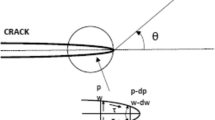Abstract
Singular terms in the crack tip elastic stress field of order σ ∼ r -3/2, r -5/2, ... are often neglected, thus rationalizing the use of the K field, σ ∼ r -1/2, as the dominant term for fracture mechanics. We find the common explanation for neglecting the more singular terms in the series solution for the crack tip stress field unsatisfying. Further, the more singular terms are non-zero and are needed to understand the energetics of fracture, i.e., J and {ie97-1}. Given that the singular terms are generally present, the rationale for the validity of the small scale yielding assumption (the basis of linear elastic fracture) is more subtle than any argument which depends on the elimination of terms with stress σ ∼ r -3/2, r -5/2, ... Our explanation for the validity of small scale yielding is as follows. First, with or without small scale yielding, the stress field outside of the nonlinear zone does contain more singular terms. In the limit as the nonlinear zone at the crack tip shrinks to zero size (SSY) we show that the r -1/2 term in the Williams expansion dominates both the more singular and the non-singular terms in an annular region somewhat removed from this zone. Further, in this limit the magnitude of the σ ∼ r -1/2 term is almost entirely determined by tractions on the outer boundary. Our theory and examples are for representative problems in mode III anti-plane shear fracture. We expect, however, that the general results also apply to mode I and mode II fracture.
Similar content being viewed by others
References
G.R. Irwin, Journal of Applied Mechanics 24 (1957) 361–364.
M.L. Williams, Journal of Applied Mechanics 19 (1952) 526–528.
M.L. Williams, Journal of Applied Mechanics 24 (1957) 109–114.
J.R. Rice, in Fracture, H. Liebowitz (ed.), Vol. 2, Academic Press, New York (1968) 191.
S.G. Larsson, and A. J. Carlsson, Journal of the Mechanics and Physics of Solids 21 (1973) 263–277.
J.W. Philips and R. J. Sanford, in Fracture Mechanics: Thirteenth Conference, ASTM STP 743 (1981) 387–402.
J.M. Etheridge and J.W. Dally, Journal of Strain Analysis 13 (1978) 91–94.
J.W. Dally and R. J. Sanford, Experimental Mechanics 27 (1987) 381–388.
G.B. Sinclair and P. S. Steif, Department of Mechanical Engineering, Carnegie-Mellon University, Private Communication.
H.F. Bueckner, Z. Agnew. Math. Mech. 50 (1970) 529–546.
T.L. Sham, International Journal of Solids and Structures 25 (1989) 357–380.
T.M. Edmunds and J. R. Willis, Journal of the Mechanics and Physics of Solids 24 (1976) 205–223.
D.S. Dugdale, Journal of the Mechanics and Physics of Solids 8 (1960) 100–104.
J.R. Rice, Journal of Applied Mechanics 34 (1967) 287–298.
J.A.H. Hult and F. A. McClintock, in Proceedings of the Ninth International Congress for Applied Mechanics Vol. 8, Free University of Bussels (1956) 51–58.
Author information
Authors and Affiliations
Rights and permissions
About this article
Cite this article
Hui, C.Y., Ruina, A. Why K? High order singularities and small scale yielding. Int J Fract 72, 97–120 (1995). https://doi.org/10.1007/BF00042823
Received:
Accepted:
Published:
Issue Date:
DOI: https://doi.org/10.1007/BF00042823



